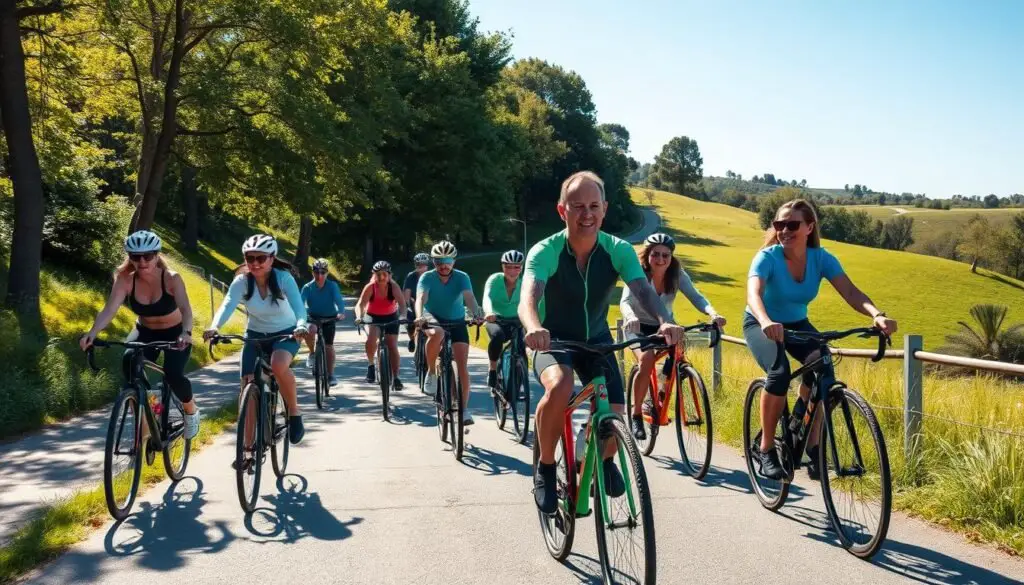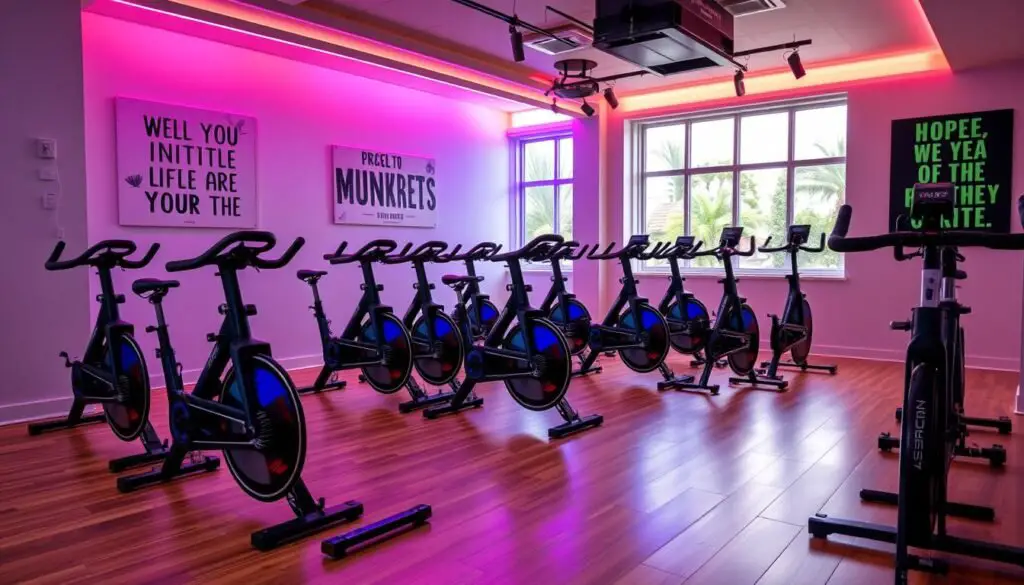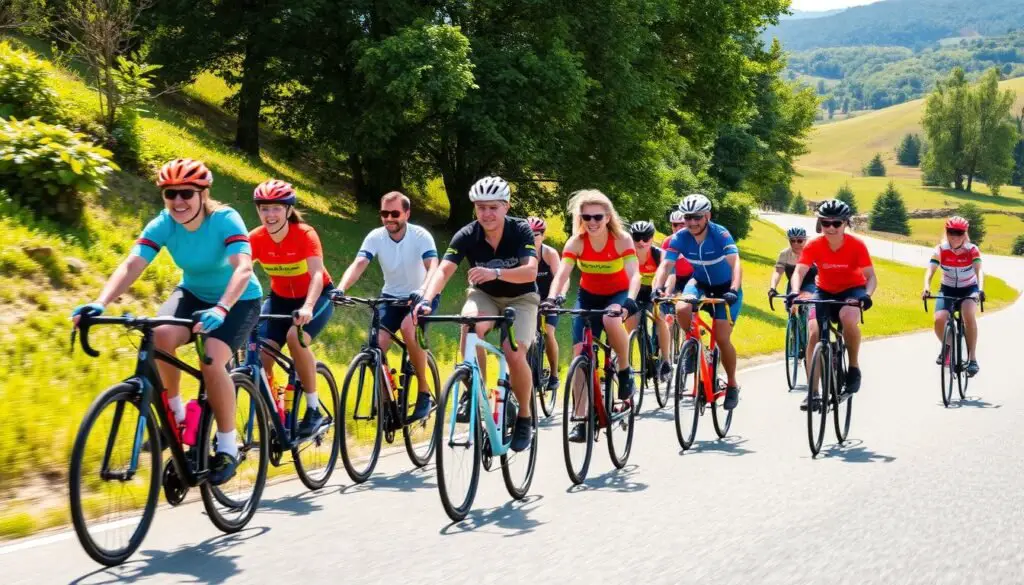Cycling is great for your heart and lungs. It also boosts blood flow, strengthens muscles, and reduces stress. It’s a top choice for burning fat and losing weight. To get the most out of cycling, increase the intensity, try HIIT, build endurance, and mix in other exercises.
There are many ways to cycle, like indoor bikes, spin classes, or biking outdoors. By using these tips, you can make cycling even more effective for losing weight and improving your body shape.
Key Takeaways:
- Cycling is an effective cardio workout for burning fat and calories
- Increase intensity, try HIIT, and build endurance for maximum fat-burning benefits
- Incorporate cross-training exercises to enhance weight loss efforts
- Cycling options include indoor stationary bikes, spin classes, and outdoor biking
- Strategize your cycling routine to unlock the full potential for fat loss and weight management
Understanding the Science Behind Fat Burning and Cycling
Cycling and fat burning are linked through many body processes. Let’s explore how your body uses fat during exercise and how metabolism affects cycling.
How Your Body Burns Fat During Exercise
When you cycle, your body uses both fat and carbs for energy. The workout’s intensity and length decide how much of each you use. At lower intensities, your body burns more fat.
But, as you cycle harder, your body starts to use carbs more. This is because carbs are a quicker energy source.
Interestingly, your body can store a lot of fat but not as much carbs. So, during long, easy rides, you can burn a lot of fat. This means you burn more calories.
The Role of Metabolism in Cycling
Metabolism is key in burning fat while cycling. High-Intensity Interval Training (HIIT) workouts keep your metabolism high even after you stop. This is called Excess Post-Exercise Oxygen Consumption (EPOC).
EPOC can last up to 36 hours after a HIIT cycling session. This means you keep burning calories long after your ride.
Power-to-Weight Ratio Explained
The power-to-weight ratio is also important in cycling. It shows how powerful you are compared to your weight. A better ratio means you can climb faster and burn more calories.

Knowing how fat burning works in cycling helps you burn more calories. By focusing on metabolism and power-to-weight ratio, you can reach your weight loss goals faster.
Benefits of Cycling for Weight Loss and Fat Burning
Cycling is a low-impact exercise that burns calories and fat. It builds muscle strength and improves heart health. Regular cycling for weight loss can lead to significant weight loss and better fitness.
Cycling is versatile, allowing workouts indoors or outdoors. This makes it great for all fitness levels and preferences.
A 2018 study in the European Journal of Obesity found women who cycle for 1.5 hours a week weigh about 2 pounds less. They also suggest that cycling and walking together can help more with weight loss.
A 2021 study in Obesity showed that mixing moderate and high-intensity workouts can lead to more weight loss. Cycling can burn 400 to 1,000 calories per hour, making it effective for fat burning.
Research found that cycling for 100 minutes a week can lower mortality risk by 17%. A person who lost 145 pounds through cycling and diet changes lost over twenty-two inches from their waistline. This shows cycling’s power to transform.
“Cycling performance and weight are interconnected, with a focus on improving the power-to-weight ratio, expressed as watts at FTP divided by body weight in kilograms.”
Creating a calorie deficit through cycling for weight loss and diet changes can lead to sustainable weight loss. Online tools can help find the right caloric intake for weight loss.

High-Intensity Interval Training (HIIT) for Maximum Calorie Burn
If you want to boost your cycling workouts and burn more calories, try high-intensity interval training (HIIT). HIIT mixes short, intense exercises with active recovery. This combo pushes your body hard and burns calories quickly.
HIIT Workout Structure for Cyclists
A HIIT cycling workout usually lasts 20-30 minutes. It starts with 30-60 seconds of hard cycling against high resistance. Then, you cycle easy for 2-3 minutes. This cycle repeats until you reach 85-100% of your max heart rate.
Sample HIIT Cycling Workouts
- The Tabata Protocol: 20 seconds of intense cycling, followed by 10 seconds of rest. Repeat this pattern for a total of 4 minutes.
- Interval Ladder: Start with 30 seconds of high-intensity cycling, followed by 60 seconds of recovery. Increase the high-intensity interval by 10 seconds each round, working up to 60 seconds of high-intensity cycling.
- Hill Repeats: Tackle a challenging hill or incline with 30-60 seconds of maximal effort, followed by a 2-3 minute descent for recovery.
Recovery Between Intervals
Recovery between intervals is key to keep your HIIT workout intense and avoid burnout. Aim for 2-3 minutes of easy, low-resistance cycling. This lets your heart rate drop before the next intense burst.
HIIT cycling workouts are great for burning calories fast, boosting your heart health, and burning fat. Adding these tough but effective sessions to your routine will help you reach your cycling and weight loss goals.

Cycling Workouts to Burn Calories: Essential Training Plans
To get the most out of cycling for losing fat and weight, you need a good training plan. Good workouts include endurance rides, high-intensity interval training (HIIT), and recovery rides. Aim for 2-3 HIIT workouts, 1-2 endurance rides, and 1-2 recovery rides each week.
Increasing the intensity and duration of your workouts is key. This keeps your body challenged and boosts fat-burning. Adding hill climbs, sprints, and tempo rides can also increase calorie burn and fitness. For example, the High-Intensity Interval Training (HIIT) Cycle Bike Pyramid Intervals Workout has intervals of 15, 30, and 45 seconds to push you hard.
The MAX Effort Climb Intervals Cycle Workout includes one-minute climbs at high resistance, above 60 RPMs. The High Cadence vs High Resistance Cycling Workout mixes jumps, sprints, climbs, and high resistance to target different energy systems and burn more calories.
| Workout | Intensity | Duration | Calories Burned* |
|---|---|---|---|
| HIIT Cycle Bike Pyramid Intervals | High | 30 minutes | 400-600 calories |
| MAX Effort Climb Intervals | High | 45 minutes | 500-700 calories |
| High Cadence vs High Resistance | High | 60 minutes | 600-800 calories |
By mixing different cycling workouts to burn calories and cycling workout plans, you can burn more fat and reach your fitness goals.

Fasted Cycling: The Morning Fat-Burning Strategy
Fasted cycling is a training method where you ride before eating breakfast. It’s done after not eating overnight. This method helps burn fat as your body uses fat for energy during the ride.
It uses your body’s natural ways to burn calories and lose weight. Cyclists find it helpful for these goals.
Benefits of Fasted Rides
Studies show fasted rides improve fat burning during long rides. They also help with insulin resistance and boost a fat-burning cytokine called IL-6. This cytokine helps with fat metabolism and muscle protection.
Moreover, fasted rides encourage the growth of more aerobic cells. This makes your body better at using both fat and carbs for energy.
Safety Precautions for Fasted Training
- Do fasted rides 2-3 times a week, keeping them at a moderate intensity in zone 2 (56-75% of FTP or 69-83% of max heart rate).
- Stay hydrated and have a snack ready in case of bonking (sudden drop in blood sugar).
- Avoid high-intensity or interval training in a fasted state, as it needs more carbs.
- Watch how your body reacts and adjust the frequency and duration of fasted rides to avoid overtraining or poor recovery.
By adding fasted cycling to your routine with caution, you can tap into its fat-burning benefits. This will help you get the most out of your cycling exercises and fat-burning cycling workouts.

Indoor vs Outdoor Cycling for Weight Loss
Both indoor and outdoor cycling can help with weight loss. Indoor cycling lets you control your workout and ride all year. Outdoor cycling offers fresh air and varied routes.
Choosing between indoor and outdoor cycling depends on what you like and your schedule. If the weather is bad, indoor cycling is a good choice. It also supports high-intensity workouts to burn more calories.
Outdoor cycling, however, is more engaging. It can boost your mood and reduce stress. The changing terrain makes your workout more challenging.
| Metric | Indoor Cycling | Outdoor Cycling |
|---|---|---|
| Calories Burned (30 minutes) | 210-315 (125 lbs), 260-391 (155 lbs), 311-466 (185 lbs) | 240-495 (125 lbs), 298-614 (155 lbs), 355-733 (185 lbs) |
| Workout Intensity | Easily programmable, high-intensity intervals | Terrain-dependent, can vary in intensity |
| Accessibility | Year-round, weather-independent | Dependent on weather and road conditions |
| Mental Benefits | Community-driven, motivating | Improved mood, reduced stress, mental clarity |
Choosing between indoor and outdoor cycling depends on your preferences and needs. Mixing both can create a balanced cycling routine. By understanding the benefits of each, you can find the best way to reach your fitness goals.

Nutrition Strategies for Fat-Burning Rides
Proper nutrition is key for getting the most out of your cycling workouts. By fueling your body right before, during, and after rides, you help with weight loss and keep your performance up. Let’s look at the main nutrition strategies for your calorie-blasting cycling sessions.
Pre-Ride Fuel Options
Before a cycling for weight loss session, eat something easy to digest. Choose carbs like oatmeal, whole-grain toast with nut butter, or a banana with honey. Go for foods high in carbs but low in fat and protein to avoid stomach issues during your ride.
During-Ride Nutrition
For longer calorie-blasting cycling rides, eat 30-60g of carbs every hour. This keeps your energy up and helps burn fat. You can get carbs from sports drinks, gels, or fresh fruit. Also, drink water or electrolyte drinks to stay hydrated.
Post-Ride Recovery Meals
After your cycling for weight loss workout, eat a mix of carbs and protein. This helps refill glycogen stores and recover muscles. Try oatmeal with Greek yogurt and berries or a grilled chicken and vegetable stir-fry with brown rice.
It’s important to balance your nutrition with your ride’s intensity and length. By fueling your body right, you can get the most out of your cycling workouts. This leads to lasting weight loss results.

Building Endurance for Enhanced Fat Burning
Cycling workouts that focus on endurance can help burn more fat. Longer, steady rides improve how your body uses fat for energy. This leads to better calorie and fat loss.
Begin with 10-15 minute rides and slowly add more time to 150 minutes or more weekly. Keep the pace moderate, around 55-75% of your VO2 max. This boosts fat burning and improves heart health.
Endurance cycling makes your body better at burning fat. It also boosts your fitness level. As you get more endurance, your body uses fat more efficiently. This makes your cycling workouts more effective for losing weight.
The Benefits of Endurance Cycling
- Improved fat-burning efficiency during exercise
- Enhanced cardiovascular fitness and overall endurance
- Increased ability to maintain a steady, moderate pace for extended periods
- Strengthened leg muscles and improved power output
- Greater mental focus and stamina during cycling sessions
Building endurance through cycling takes time and effort. Aim for one or two longer rides weekly. Focus on a pace you can keep up for a while. This not only burns more calories and fat but also prepares you for harder rides.
| Endurance Cycling Benefits | Impact on Fat Burning |
|---|---|
| Improved Cardiovascular Fitness | Increased ability to use fat as a primary fuel source during exercise |
| Enhanced Muscular Endurance | Ability to sustain moderate-intensity cycling for longer durations |
| Increased Metabolic Efficiency | More effective calorie and fat burn during and after cycling sessions |
| Greater Mental Stamina | Improved focus and motivation to push through longer, more challenging rides |

By focusing on endurance in your cycling, you can maximize fat burning and weight loss. Pair this with a good diet, and you’re on your way to reaching your fitness goals.
Combining Strength Training with Cycling
Adding strength training to your cycling routine can change the game for calorie and fat burning. This mix of exercises boosts your fitness, metabolism, and cycling skills.
Essential Exercises for Cyclists
As a cyclist, focus on exercises that work many muscles at once. Key exercises include:
- Squats
- Deadlifts
- Lunges
- Core-strengthening exercises like planks and crunches
Weekly Training Schedule
Balance your cycling and strength training. A good weekly plan is:
- 3-4 cycling workouts
- 2 strength training sessions, focusing on compound movements
- Adequate rest days for recovery
Do your cycling before strength training. If on the same day, wait at least six hours. This avoids conflicting signals and helps your body recover and adapt.
| Training Phase | Cycling Workouts | Strength Training |
|---|---|---|
| Base Phase | 3-4 sessions per week | 2-3 sessions per week |
| Build Phase | 3-4 sessions per week | 1-2 sessions per week, with emphasis on core |
| Specialty Phase | 3-4 sessions per week | 1 session per week |
This balanced approach maximizes the benefits of cycling workout plans and cycling for weight loss. You’ll build lean muscle, boost your metabolism, and enhance your cycling performance.

Heart Rate Zones for Optimal Fat Burning
Cycling exercises can be optimized for fat-burning by understanding your heart rate zones. The fat-burning zone is between 60-70% of your maximum heart rate. But, adding higher-intensity workouts in zones 3-5 can burn more calories and improve your heart health.
To get the most out of your cycling workouts, use a heart rate monitor. It helps you keep the right intensity and mix up your training in different heart rate zones.
- Most people have a resting heart rate between 60 and 100 beats per minute.
- The fat-burning heart rate is typically around 70% of the maximum heart rate.
- Experts suggest working at 70 to 85% of the maximum heart rate for vigorous activity, known as the target heart rate.
- A moderate heart rate ranges between 50 and 70% of the maximum heart rate.
To find your maximum heart rate, use the formula: 220 – your age = maximum heart rate. This helps you figure out the best cycling exercises and fat-burning cycling workouts for you.
By knowing and using your heart rate zones, you can boost fat burning and heart health in your cycling routine. Try different intensities and track your progress to find the perfect fit for your fitness goals.
Common Mistakes to Avoid During Fat-Burning Rides
When cycling to lose weight, it’s important to avoid common mistakes. These include overtraining, not eating enough, not resting enough, and only doing high-intensity workouts. Over 20 years of coaching have shown these errors.
One big mistake is cutting calories too much. This can make you tired, lower your performance, and slow down your metabolism. Instead, eat well before, during, and after rides. Most athletes use carbs for about half their energy, especially when they’re working hard.
Another mistake is ignoring strength training and recovery rides. Doing off-bike exercises can help you cycle better and burn more fat. Also, make sure to rest between hard rides to keep improving.
Getting your bike fitted right is key to avoid injuries and ride better. Don’t compare yourself to others. Just keep up with your workouts and diet, and you’ll reach your goals.
| Common Mistake | Impact | Solution |
|---|---|---|
| Overtraining | Fatigue, decreased performance | Incorporate recovery rides and strength training |
| Underfueling | Decreased energy, slower metabolism | Properly fuel before, during, and after rides |
| Neglecting recovery | Increased risk of injury, burnout | Allow for adequate rest and recovery between sessions |
| Focusing only on high-intensity | Decreased overall calorie burn | Incorporate a variety of cycling intensities and off-bike exercises |
Avoid these mistakes and stick to a balanced training and nutrition plan. This will help you succeed in cycling for weight loss and cycling workouts to burn calories. Remember, being consistent and patient is crucial for reaching your goals.
Tracking Progress and Measuring Results
To reach your cycling fitness goals, it’s key to track your progress. By watching important metrics, you can stay motivated. You can also make smart changes to your cycling workout plans and calorie-blasting cycling routine.
Tools and Apps for Monitoring
There are many tools to help you track your progress. Smart scales can show your body composition, while fitness trackers give you heart rate and calorie burn data. Cycling computers offer performance stats like power output and cadence.
Apps like Strava, MyFitnessPal, and TrainingPeaks give a full view of your workouts, diet, and progress. They help you see how far you’ve come.
Setting Realistic Goals
- Make your goals based on your current fitness and lifestyle. This way, they’re reachable.
- Set goals for both performance (like more power or endurance) and body changes (like less body fat).
- Keep checking and updating your goals as you get better. This keeps you motivated and seeing results.
Remember, making progress takes time and patience. By tracking your metrics and setting realistic goals, you’ll get the most out of your cycling workout plans and calorie-blasting cycling efforts.
“The beauty of data tracking in cycling is that it provides tangible evidence of your hard work and progress. Use it to your advantage and stay motivated on your fitness journey.”
Recovery Techniques for Fat-Burning Workouts
Proper recovery is key to getting the most out of your cycling workouts. It helps you stay strong, avoid burnout, and keep moving forward. Using the right recovery methods is crucial for your fitness journey.
An active recovery ride is a great strategy. Choose a light spin session that keeps your heart rate up but doesn’t exhaust you. This helps your blood flow, removes lactic acid, and keeps your muscles ready without too much strain.
Don’t forget about your post-workout nutrition. Eat a meal or snack with lean protein, complex carbs, and healthy fats. This helps fix your muscles and fills up your glycogen stores for the next workout.
- Getting enough sleep (7-9 hours) is vital for muscle repair and health.
- Stretching, foam rolling, and massage help with muscle recovery and boost flexibility.
- Try cross-training like yoga or swimming on rest days for a different workout.
By mixing intense cycling with proper recovery, you can avoid burnout, aid in fat loss, and reach your fitness goals.
“Proper recovery is essential for maximizing the benefits of your fat-burning cycling exercises and supporting your long-term fitness goals.”
Advanced Cycling Techniques for Increased Calorie Burn
Discover how to burn more calories with advanced cycling techniques. Learn strategies that boost your fitness and burn more calories during rides.
Try adding more hill climbs to your workouts. Climbing hills makes your ride more intense. Research shows it can burn up to 1,000 calories in an hour. Include tough hill climbs in your interval training to target heart rate zones and burn more calories.
Also, try sprint intervals. These are short, all-out efforts followed by rest. This method uses your anaerobic energy, leading to more calorie burn during and after your workout.
For better endurance and fat burning, use “sweet spot” training. Ride at 88-93% of your maximum power. This zone boosts fitness and helps burn fat efficiently.
- Try “over-under” intervals, switching between high and moderate intensities. This challenges your body and increases calorie burn.
- Join group rides or races to increase intensity and motivation. This unlocks more calorie-burning potential.
- Use power meters to target your training zones and track calorie burn. This ensures you get the most from your cycling workouts.
By using these advanced techniques, you’ll boost your calorie-burning potential. This will transform your fitness journey and help you reach your weight loss goals.
“Cycling uphill may burn up to 1,000 calories in one hour; incorporating high-resistance uphill cycling in interval training sessions is effective.”
Conclusion
Cycling is a great way to burn calories and lose weight. It’s fun and effective. By trying different workouts like HIIT, endurance rides, and strength training, you can burn more fat and get fitter.
Good nutrition, rest, and tracking your progress are important. They help you reach and keep your weight loss goals.
Remember, losing weight takes time, but it should be fun. Cycling can greatly improve your health and fitness. You can use indoor cycling on platforms like CAROL Bike or ROUVY, or ride outdoors.
By following the tips in this article, you can start a rewarding cycling journey. It will help you lose weight and feel better overall. So, take on the challenge, stay committed, and see how cycling can change your body and mind.
FAQ
What are the benefits of cycling for weight loss and fat burning?
Cycling is great for your heart and lungs. It improves blood flow and builds muscle strength. It also lowers stress and helps burn fat.
How does the intensity and duration of cycling affect fat burning?
Cycling faster burns more calories. Steady cycling for 60 minutes burns about 300 calories. High-intensity cycling can burn up to 372 calories in 30 minutes for a 155-pound person.
Metabolism plays a big role in fat burning. HIIT workouts keep your metabolism high even after you stop exercising.
What is the role of power-to-weight ratio in cycling for fat burning?
The power-to-weight ratio is key for climbing. Improving it boosts fat burning and cycling efficiency.
How can high-intensity interval training (HIIT) help maximize calorie burn during cycling?
HIIT involves short, intense bursts followed by easy periods. For cycling, this means 30-60 seconds of hard cycling followed by 2-3 minutes of easy cycling. Repeat for 20-30 minutes. HIIT burns more calories, improves fitness, and reduces fat.
What are some effective cycling workouts for burning calories and fat?
Good workouts include endurance rides, HIIT, and recovery rides. Adding hill climbs, sprints, and tempo rides boosts calorie burn and fitness.
What are the benefits of fasted cycling for fat burning?
Fasted cycling is riding before breakfast. It burns more fat as fuel. Benefits include better fat oxidation and VO2 max increases. But, limit fasted rides to 2-3 times a week and keep them moderate.
What are the advantages and disadvantages of indoor and outdoor cycling for weight loss?
Indoor cycling offers controlled workouts and year-round access. Outdoor cycling provides variety and fresh air. Choose based on preference, climate, and time.
What are the nutritional considerations for fat-burning rides?
Pre-ride, eat easy-to-digest carbs for energy. During long rides, consume 30-60g of carbs per hour. Post-ride, eat carbs and protein to recover. Stay hydrated before, during, and after rides.
How can building endurance through longer, steady-state rides enhance fat-burning capacity?
Endurance training makes your body better at using fat for fuel. Do one or two longer rides a week at moderate intensity. This boosts fat burning and fitness.
How can combining strength training with cycling improve fat burning and overall performance?
Strength training with cycling boosts fat burning and performance. Focus on squats, deadlifts, lunges, and core exercises. Aim for two strength sessions a week.
How can understanding heart rate zones optimize fat burning during cycling?
The fat-burning zone is 60-70% of maximum heart rate. But, higher intensity workouts burn more calories and improve fitness. Use a heart rate monitor to track intensity.
What are some common mistakes to avoid during fat-burning cycling workouts?
Avoid overtraining, underfueling, neglecting recovery, and focusing only on high-intensity workouts. Don’t restrict calories too much. Include strength training and recovery rides. Ensure a proper bike fit to prevent injuries.
How can you track progress and measure results during your cycling weight loss journey?
Use smart scales, fitness trackers, and cycling computers to track progress. Apps like Strava and MyFitnessPal help monitor workouts and nutrition. Set achievable goals based on your current fitness and lifestyle.
What recovery techniques are important for fat-burning cycling workouts?
Proper recovery is key for fat burning and performance. Include active recovery rides, proper nutrition, enough sleep, and stress management. Stretch, foam roll, and massage to aid muscle recovery.
What are some advanced techniques for increasing calorie burn during cycling?
Try hill climbs, sprint intervals, and longer rides to burn more calories. “Sweet spot” training at 88-93% of functional threshold power boosts fat burning. Experiment with “over-under” intervals for more calorie burn.

One Reply to “Cycling Workouts to Burn Calories: Top Fat-Burning Tips”